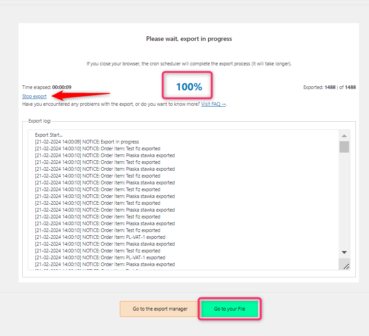Contents
Export Manager
The tab contains a table that allows you to quickly manage all exports and view their most important statistics. Click the Create new button if you need a new export file.

Export name
The column shows the name of the export and additional options (when hovering over its area):
- Edit - allows you to edit the export from the beginning (from step 1/4)
- Edit mapping - enables the export to be edited at the Product Mapper stage (from step 3/4)
- Edit Options - allows editing the export at the Export Options stage (from step 4/4)
- Duplicate - allows you to clone the export with all its settings
- Delete - allows the export to be deleted
Cron schedule
The column shows the schedule (deadline) for automatic export to file.
Actions
The column shows actions unrelated to the export configuration:
- Export now - allows you to start the export process manually and preview it
- Stop synchronization - allows you to disable automatic export for the Cron schedule (set in step 4/4) as long as automatic export is enabled
Status
The column shows the current status of the export:
- Synchronization active - export will run automatically for cron schedule
- Synchronization stopped - the export will not start automatically (it is possible to activate it or run it manually)
- Synchronization in progress - the export process has started and is in progress
Export statistics
The column contains information related to the products e.g. how many of them were exported or omitted during the process.
Created
The column shows the date the export was created.

Export setup steps
Export: step 1
The first step contains basic information about the type of file to be exported. You can choose from three file types :
- CSV,
- XML,
- JSON.
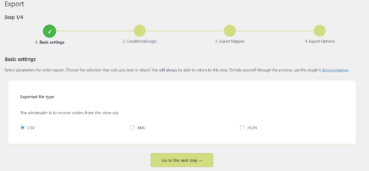
Conditional Logic: step 2
The second step contains conditional logic settings to further narrow down which orders will be included in the export. An order will be included if it meets certain conditions.
- Select from the list which order parameter will be checked.
The available options are:- Order status,
- Order e-mail address,
- Order currency,
- Date of order,
- Total value of order,
- Order type,
- Product name,
- Product category,
- Product SKU,
- Product tag.
- Choose what will be the relation between the parameter and the value.
The available options depend on the selected parameter:- is in,
- is equal to,
- includes,
- from date,
- to date,
- is greater than,
- is less than,
- is equal to,
- is.
- Enter the value to be checked. If the value is not completed - then the condition will not be taken into account.
Available formats are:- Order status (multi-select),
- Text or value - use vertical dash (|) separator to separate entered values,
- Date selection from the calendar,
- Order or return,
- Category (multi-select),
- Tag name (multi-select).
- Click the PLUS button if you need another condition. Click the MINUS button if you no longer need a specific condition.
Export order if 'Order Status' is 'Completed' +An order will be included in the export if its status is completed and it has occurred since 01.02.2024.
Export order if 'Date' is from '01.02.2024'.
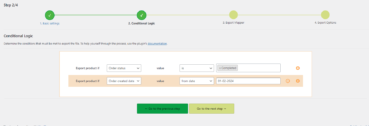
Product mapper: step 3
The third step contains sections with settings for information that will be exported with the orders.
Product fields
The section contains a table showing all the fields that are available for export.
Uncheck the checkbox next to a particular row, with the result that the field was not included in the export.
The second column contains the original name of the field in WooCommerce - this name is not editable.
Enter your own field name in the Field name column - this will replace the original field name (optional).
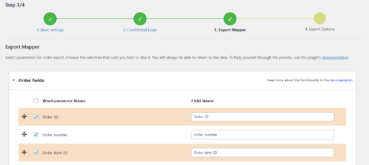
Export options: step 4
The fourth step contains the rest of the settings.
Export name
Enter a name for the export (optional). The name will be shown in the table in the Export Manager tab. The default name includes the date and time the export was created.
Products in one batch
Choose how many products will be exported in a single package - adjust this setting to your server. The default value is 100.
Creating an export file is divided into smaller packages - this allows you to adjust the entire process to the performance of the server on which the store is hosted. If the store uses an efficient server - then the process will be faster by setting more products in the package (e.g. 200). If the store uses a less efficient server - then the process will be slower. But the export will not cause an error by setting a lower value (e.g. 20).
You can read about changing the wp memory limit in WordPress. Also, it's possible that the max_execution_time limit for WordPress/ PHP scripts is too low.
Separator
Enter a separator between the values in the file. The default value is a comma (,).
Cron schedule
Set cron schedule for automatic export. Select the day of the week and the time of the planned export run from the list.
FTP path
Enter your own location to save the file on the server.
Send to e-mail
Check this option if you would like an email to be sent after the export has been completed.
E-mail recipients
Enter the addresses of the recipients to whom you want to send the message.
Email title
Enter the title of the message you wish to send.
Body of the email
Enter the body of the e-mail to be sent. You can freely format it in the window to suit your needs.
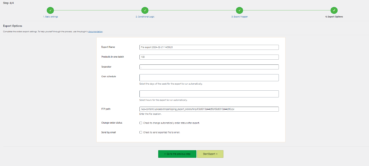
Export log
The Start Export button saves the settings and launches the export statistics and summary screen. Closing the window or browser will not stop the export as cron will finalize the whole process (but it will take longer).
The items visible on the screen are:
- the time elapsed since the export was started
- percentage of export progress
- export statistics e.g. 100 | of 1000 means that 100 products out of 1000 have been exported
- Stop export button used to stop the export
- export logs with a summary of the work of the exporter
